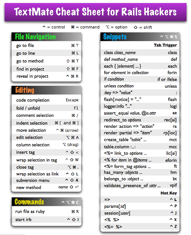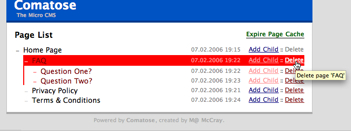
Perl is particularly well known for its one-liners from the command prompt, but Ruby is pretty adept at it too. David P Thomas has put together a collection of about 100 Ruby one-liners in a single text file for us all to enjoy. Read More

Perl is particularly well known for its one-liners from the command prompt, but Ruby is pretty adept at it too. David P Thomas has put together a collection of about 100 Ruby one-liners in a single text file for us all to enjoy. Read More

The indefatigable Assaf Arkin has done it again by developing a new Ruby HTML scraping toolkit, scrAPI. Peter Szinek recently wrote a popular article about scraping from Ruby using Manic Miner, RubyfulSoup, REXML, and WWW::Mechanize, but none of these are as immediately useful as scrAPI.. so why?
scrAPI lets you scrape from HTML using CSS selectors. For example, here’s Assaf’s example that defines scraper objects that can scrape auctions from eBay:
ebay_auction = Scraper.define do
process "h3.ens>a", :description=>:text,
:url=>"@href"
process "td.ebcPr>span", :price=>:text
process "div.ebPicture >a>img", :image=>"@src"
result :description, :url, :price, :image
end
ebay = Scraper.define do
array :auctions
process "table.ebItemlist tr.single",
:auctions => ebay_auction
result :auctions
end
Now that the objects are set up ready to scrape, you can put them into action like so: Read More
auctions = ebay.scrape(html)
# No.

Install now with sudo gem install classroom
ClassRoom (RubyForge project) is a project to develop a distributed ‘class server’ powered by DRb that I have been working on. Let’s skip long explanations and jump into code. First, we’ll create a very basic “Dog” class with some basic features:
class Dog
attr_accessor :name
def self.count
@@count ||= 0
end
def initialize(options)
self.name = options[:name]
@@count ||= 0
@@count += 1
end
end
Next, we’ll create a program that can use Dog via ClassRoom:
require ‘rubygems’
require ‘classroom’
class_server = ClassRoom::Client.new(‘classroom://:2001′)
class_server.add_class(IO.read(‘dog.rb’))
class_server.load_class(:all)
puts "There are #{Dog.count} dogs"
fido = Dog.new(:name => "Fido")
puts "There are #{Dog.count} dogs"
rufus = Dog.new(:name => "Rufus")
puts "There are #{Dog.count} dogs"
puts "fido’s name is #{fido.name}"
# => There are 0 dogs
# => There are 1 dogs
# => There are 2 dogs
# => fido’s name is Fido
Take care to notice that at no point is dog.rb actually included/’require’d. Read More

Scaffolding is not meant to be a final solution for any application. It’s designed to provide ‘scaffolding’ for you to extend and improve. However, the developers of Trestle believe that the scaffolding could be improved significantly and have released their own version.
The trestle generator is an adaptation of the Rails scaffold generator. It produces scaffolding that’s more like production-quality code while maintaining all the rapid goodness you know and love about Rails.
The primary difference is that the HTTP verbs GET and POST are respected and used properly, as opposed to the system in Rails’ default scaffolding. This also allows trestles to be more succinct, with just four actions (index, new, edit, and destroy). Read More
Geoffrey Grosenbach introduces the RaPT Plugin Manager for Rails, the answer to the problem of slow plugin installation. Installable as a gem (gem install rapt), RaPT caches the locations of different plugins so that installation is quick and easy. Future plans include developing a central plugin repository, auto-announcement of self-developed plugins, and automatic plugin upgrading. If you want the files direct, check out the Rubyforge project site for RaPT. Read More
This library is so amazingly cool that it requires no descriptions beyond these code examples:
“runs”.en.present_participle
# => “running”
2004.en.numwords
# => “two thousand and four”
“cow”.en.quantify( 20_432_123_000_000 )
# => “tens of trillions of cows”
“ruby”.en.plural
# => “rubies”
Or what about?
allobjs = []
ObjectSpace::each_object {|obj| allobjs << obj.class.name}
puts “The current Ruby objectspace contains: ” +
allobjs.en.conjunction( :generalize => true )
The current Ruby objectspace contains: thousands of Strings,
thousands of Arrays, hundreds of Hashes, hundreds of
Classes, many Regexps, a number of Ranges, a number of
Modules, several Floats, several Procs, several MatchDatas,
several Objects, several IOS, several Files, a Binding, a
NoMemoryError, a SystemStackError, a fatal, a ThreadGroup,
and a Thread
Go learn more. Read More
You can test your controllers, your models, and, well, most of your application, but till now there hasn’t been a way to explicitly test your Rails application’s helpers. Now there’s a solution.. the helper_test plugin (with source and instructions). Read More

assert_select is a plugin by Assaf Arkin that allows you to use CSS selectors in your functional tests to check that certain HTML elements match your assertions. On the surface, this isn’t too far removed from using why’s Hpricot to do assertions on HTML, but in reality having the full power of CSS selectors available changes everything (Update! Hpricot has XPath and CSS addressing too!). Some examples:
# Form includes four input fields
assert_select “form input”, 4
# Page does not have any forms in it.
assert_select “form”, false, “Page must contain no forms”
def test_login_form_has_all_fields
get :login
assert_select “form[action=http://myapp/login] input” do |inputs|
assert_equal 3, inputs.size
assert_select inputs[0], “input[type=name][name=username]”
assert_select inputs[1], “input[type=password][name=password]”
assert_select inputs[2], “input[type=submit][value=Login]”
end
end

Arcadian Visions have released a plugin for Mac OS X’s Spotlight that lets you quickly search your Ruby source code. Once indexed, you can search by module, class, method, general contents, or code comments. (Found via Have GNU, Will Travel)
(Added: Tread with caution! It seems one user is having problems installing this on their Intel x86 powered Mac. See comments.) Read More
New to Rails 3? Check out the Ruby on Rails 3 Tutorial book and screencast.
A book and screencast series showing you how to develop and deploy industrial-strength Rails apps in a direct, step by step way. The screencast series includes 12 lessons over more than 15 hours! Get the best “over the shoulder” experience of following what a top Rails 3 developer does when building an app today. Click here to learn more.
Please note that this post is over four years old – it’s from 2006! As such, these tips were relevant to Rails 1.2 and this content is woefully out of date. Read More

Mike Clark has produced a single page PDF cheat sheet of about fifty TextMate keyboard shortcuts to speed up your Ruby development. As a long time TextMate user who never uses the shortcuts, this is very useful. Great work, Mike! Read More

RadiantCMS has been getting a lot of press in the Rails world lately as the first, interesting Rails powered CMS (it’s open source too), but now comes Comatose, a ‘micro CMS’ that works as a Rails plugin, allowing you to easy integrate it with your own application. As Matt McCray, the developer, says:
Lately, I’ve had a recurring issue arise on my projects: They generally require a few content pages. Nothing fancy. Just a privacy policy, terms & conditions, an FAQ, that kind of thing.
I don’t really want to make these static HTML pages. They are likely to change at some point, especially the FAQ. Read More

It’s still pretty new, but Shattered Ruby looks interesting. It’s a Ruby game development framework that runs on Mac OS X, Linux, and Windows, and uses the Ogre3D libraries (which support OpenGL and DirectX) for graphics. There’s even a blog. It has some pretty neat event handling:
key :pressed => [:a, :b], :action => :do_something
def do_something
puts "will be called when a or b is pressed"
end
I want to find some time to play with this.. Read More
MeantimeFilter is an interesting new plugin for Rails by Roman Le Negrate. It’s a little like around_filter, but rather than using a class with ‘before’ and ‘after’ methods, it uses a single method (like the other types of filter) and passes in the method to wrap ‘around’ as a code block. You can then yield to this or pass it into anything you like. An example: Read More
class PostsController < ApplicationController
before_filter :authenticate
meantime_filter :scope_posts_to_user
# Displays the posts of the logged in user.
def show
@posts = Post.find(:all)
end
def create
# …
@post = Post.create(params[:post]) # Automatically associated to @user
# …
Paul Battley has developed a Ruby to JavaScript converter. I’m trying to think what this is useful for, but this is an amazing results for just a few hours’ work.